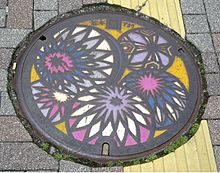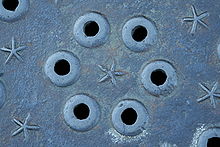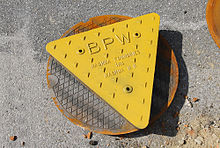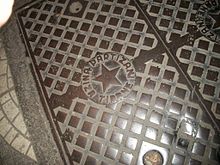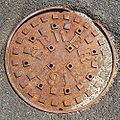- Manhole cover
-
A manhole cover is a removable plate forming the lid over the opening of a manhole, to prevent anyone from falling in and to keep unauthorized persons out.
Since the era of ancient Rome, sewer grates made from stone have been used to keep people from falling into the sewage and to catch anything large that might otherwise fall in.
Manhole covers usually weigh more than 50 kg, partly because the weight keeps them in place when traffic passes over them, and partly because they are often made out of cast iron, sometimes with infills of concrete. This makes them inexpensive, strong, and heavy. A manhole cover sits on metal base, with a smaller inset rim which fits the cover. The base and cover are sometimes called "castings," because they are made by a casting process.[1]
They usually feature "pick holes," in which a hook handle is inserted to lift them. Pick holes can be concealed for a more watertight lid, or can allow light to shine through. A manhole pick or hook is typically used to lift them, though other tools can be used as well, including electromagnets.
Manhole covers are generally made using sand casting techniques.[1] India has become a major player in the industry because of cheaper, lower-grade iron and lax labor and safety laws.[2]
Although the covers are too large to be collectible, their ubiquity and the many patterns and descriptions printed on them has led some people to collect pictures of covers from around the world.
Despite their weight and cumbersome nature, manhole covers are sometimes stolen, usually for resale as scrap, particularly when metal prices rise.[3][4]
Contents
Circular shape
The question of why manhole covers are typically round was made famous by Microsoft when they began asking it as a job-interview question.[5][6] Originally meant as a psychological assessment of how one approaches a question with more than one correct answer, the problem has produced a number of alternate explanations, from the pragmatic ("Manhole covers are round because manholes are round.")[5] to the philosophical.
Reasons for the shape include:
- A round manhole cover cannot fall through its circular opening, whereas a square manhole cover may fall in if it were inserted diagonally in the hole. (A Reuleaux triangle or other curve of constant width would also serve this purpose, but round covers are much easier to manufacture. The existence of a "lip" holding up the lid means that the underlying hole is smaller than the cover, so that other shapes might suffice.)
- Round tubes are the strongest and most material-efficient shape against the compression of the earth around them, and so it is natural that the cover of a round tube assume a circular shape.
- Similarly, it is easier to dig a circular hole and thus the cover is also circular.
- The bearing surfaces of manhole frames and covers are machined to assure flatness and prevent them from becoming dislodged by traffic. Round castings are much easier to machine using a lathe.
- Circular covers do not need to be rotated to align them when covering a circular manhole.
- Human beings have a roughly circular cross-section.
- A round manhole cover can be more easily moved by being rolled.
- A round manhole cover is cheapest to manufacture related to other shapes because it requires the least amount of metal to cover an opening wide enough for a person to get through.
- Most manhole covers are made by a few large companies. A different shape would have to be custom made.
Other manhole shapes can be found, usually squares or rectangles. Nashua, New Hampshire may be unique in the U.S. for having triangular manhole covers that point in the direction of the underlying flow. The city is phasing out the triangles, which were made by a local foundry, because they are not large enough to meet modern safety standards and a manufacturer for larger triangles cannot be found.[7] Some manhole covers in Hamilton, Bermuda are triangular, and hinged. Some triangular water-main covers also exist in San Francisco.[8]
Manhole covers and race cars
Because of their aerodynamic design, modern racing cars create enough vacuum to lift a manhole cover off the ground. During races on city streets, manhole covers must therefore be welded down to prevent injury. In 1990, during the Group C World Sportscar Championship race at Circuit Gilles Villeneuve, located in a public park in Montréal, Quebec, a Brun Motorsport Porsche 962 struck a manhole cover that was lifted by the ground effect of the car he was following, a Courage C24 Porsche, causing the Porsche to catch fire, and with the safety issues, the race ended shortly afterwards.[9]
Propelled into space
According to urban legend, a manhole cover was accidentally launched from its shaft during an underground nuclear test in the 1950s, at great enough speed to achieve escape velocity. The myth is based on a real incident during the Operation Plumbbob nuclear tests, where a 900kg steel plate cap was blasted off the test shaft at an unknown velocity, and appears as a blur on a single frame of film of the test; it was never recovered. A calculation before the event gave a predicted speed of six times Earth escape velocity, but the calculation is unlikely to have been accurate and they did not believe that it would leave the Earth in reality. After the event, Dr. Robert R. Brownlee described the best estimate of the cover's speed from the photographic evidence as "going like a bat out of hell!!"[10][11]
Other uses
A robotics research paper in 2011 suggested that robots could examine the shape of specific manhole covers and use it to calculate their position, as a double-check on GPS data.[12]
Gallery
-
Trondheim manhole cover, Trondheim, Norway
-
Prague manhole cover
-
Cologne manhole cover
-
Lithuanian SSR standard manhole cover of the city water main in Vilnius.
-
a common New York City outsourced sewer cover seen throughout the area.
-
triangular, hinged manhole cover in Hamilton, Bermuda.
See also
- Manhole cover theft
- List of New York City manhole cover abbreviations
- Public utility
- SPQR
- Storm drain
- Coal hole
References
- ^ a b Manhole Cover: How Products are Made, enotes.com.
- ^ Timmons, Heather, and J. Adam Huggins. "New York Manhole Covers, Forged Barefoot in India". The New York Times, November 26, 2007. Accessed December 19, 2008.
- ^ Liu Shinan. "Severely punish theft of manhole covers". China Daily, December 21, 2005. Accessed December 19, 2008.
- ^ Mickle, Bryn. "Hundreds of manhole covers stolen around Genesee County". Flint Journal, July 14, 2008. Accessed December 19, 2008.
- ^ a b Poundstone, William (2003). How Would You Move Mount Fuji? Microsoft's Cult of the Puzzle – How the World's Smartest Company Selects the Most Creative Thinkers. Little, Brown. ISBN 0-316-91916-0.
- ^ Davis, Jim (2009-02-10). "Why Are Manhole Covers Round?". Joblossguide.com. http://www.joblossguide.com/2009/02/why-are-manhole-covers-round_10.html. Retrieved 2011-04-08.
- ^ Brooks,David. "Nashua’s triangular covers historic and unique". Nashua Telegraph, Aug. 21, 2011. Accessed Aug. 21, 2011.
- ^ MAA.org picture of triangular water-main in San Francisco
- ^ "Classic Cars Race Results Database". Wspr-racing.com. http://wspr-racing.com/wspr/results/wscc/ms1990.html. Retrieved 2011-04-08.
- ^ "Learning to Contain Underground Nuclear Explosions By Dr. Robert R. Brownlee - June 2002". Radiochemistry.org. http://www.radiochemistry.org/history/nuke_tests/plumbbob/brownlee.htm. Retrieved 2011-04-08.
- ^ "Operation Plumbob at the Nuclear Weapon Archive". Nuclearweaponarchive.org. http://nuclearweaponarchive.org/Usa/Tests/Plumbob.html#PascalB. Retrieved 2011-04-08.
- ^ Marks, Paul (2011-02-08). "I, for one, welcome our manhole-seeking overlords". New Scientist. http://www.newscientist.com/blogs/onepercent/2011/02/i-for-one-welcome-our-manhole-.html. Retrieved 2011-04-08.
Further reading
- Melnick, Mimi (1994). Manhole Covers. Cambridge, Mass.: MIT Press. ISBN 0-262-13302-4.
- Raymond, Douglas (2007). Transylvanian Street Metal. http://www.blurb.com/bookstore/detail/77885
- Stuart, Diana (2003). Designs Underfoot: The Art of Manhole Covers in New York City. Sharon, Conn.: Design Books. ISBN 1-58574-639-8.
External links
- Rampant manhole theft in China, The Age, Feb 8, 2006
- Manhole Covers in Space – exhaustive article by Debbie Moorhouse
- The Pascal-B nuclear test
- Manhole Lids Wiki
- Report by Siemens for the State of Massachusetts concerning manhole cover explosions
- World Sewer Cover Web site
- Great manhole covers of the world
Categories:- Street furniture
- Public utilities
- Subterranea (geography)
Wikimedia Foundation. 2010.




